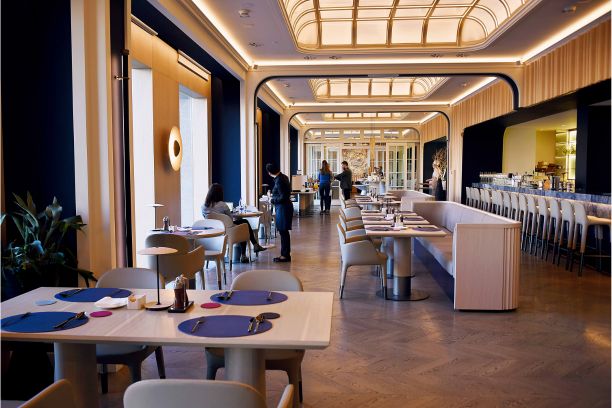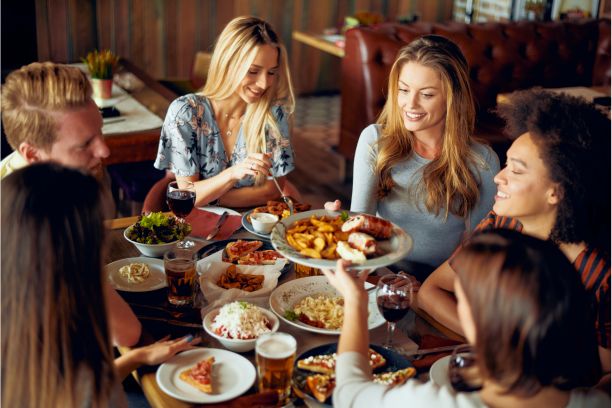7 marketing strategies for restaurants
In a highly competitive and constantly evolving industry, restaurant marketing has become a crucial aspect of the success of any restaurant business.
With the rise of digital marketing, there are now more opportunities than ever to reach potential customers and establish a strong brand presence.
We’ll explore seven effective marketing strategies that can help you engage new customers, retain existing ones and ultimately increase your restaurant’s sales.
So, let’s get to work!
1. Building online communities with social media marketing
Building online connections with social media is a powerful way to promote your restaurant and reach potential customers.
By developing a strong online presence, you can interact with your audience, share details about your menu and offerings, and create a sense of community around your brand.
Platforms like Facebook, Twitter and Instagram are ideal for this type of promotion, as they allow you to communicate with customers in a more personal and interactive way.
By consistently providing high-quality content and engaging with your followers, you can build a loyal following and position your restaurant as a trusted and respected source of delicious food and great service in the food marketing world.
One of the main advantages of using social media to promote your restaurant is that it allows you to reach a wider audience than traditional advertising methods.
By sharing your content and interacting with your followers, you can attract potential customers who may not have heard of your restaurant before.
In addition, social media platforms provide valuable information about your audience’s preferences and behaviors, allowing you to customize your marketing strategy to their needs and interests.
By building a strong online community, you can not only increase your brand recognition and reputation, but also drive more traffic to your restaurant and increase your sales in the competitive world of restaurant marketing.
2. Build an audience with content marketing
Developing an audience using useful content is one of the most effective approaches for restaurants to boost their web presence and attract new customers.
By providing interesting and informative content, such as blog posts, videos and infographics, restaurants can position themselves as specialists in their industry and gain a loyal following.
This can lead to improved visits to their website, more followers on social media and, ultimately, more customers.
Content marketing is a long-term plan that requires consistency and endurance, but it can have a significant impact on a restaurant’s success.
A key element of content marketing for restaurants is to understand your target audience and create content that resonates with them.
For example, a family restaurant can create content that appeals to parents, such as healthy meal ideas for kids or tips for dining out with children.
By catering to the interests and needs of their audience, restaurants can establish a relationship of trust and credibility with their customers, which can lead to increased loyalty and repeat business.This is one of the most important marketing strategies for any restaurant.
Another vital aspect of content marketing is optimizing content for search engines.
By including applicable keywords and phrases in their content, restaurants can improve their search engine rankings and drive more organic traffic to their website.
This can be achieved through techniques such as on-page optimization, link building and keyword research.
Restaurants can also use tools such as Google Analytics to track the performance of their content and make necessary changes.
This is an essential part of any restaurant’s marketing plan.
Finally, restaurants can leverage social media to promote their content and reach a wider audience.
By sharing their content on platforms such as Facebook, Twitter and Instagram, restaurants can encourage their followers to interact with their brand and share their content with their own networks
This can increase visibility and brand awareness, as well as traffic to your website.
Social media is a powerful tool for restaurants to connect with their audience and build a strong online presence, making it an integral part of any content marketing strategy.
3. Promote the restaurant with digital advertising
The digital era has revolutionized the way businesses promote their services, and restaurants are no exception.
Display ads, for example, can be used to target specific audiences based on their demographics, location and interests, which increases the chances of reaching potential customers.
In addition, retargeting campaigns can be used to retarget customers who have interacted with your restaurant online.
Search engine marketing (SEM) is another powerful tool for promoting your restaurant, as ads can be placed on search engine results pages.
By bidding on specific keywords, your ads can appear at the top of search results when someone searches for those keywords.
Combining display advertising and SEM can help increase visibility and drive traffic to your website.
Creating an exceptional user experience is also essential.
Optimize your website and landing pages for mobile devices and use cookies to track user behavior and target them with personalized ads.
This can help convert leads into real customers.
Finally, regularly measure the success of your campaigns with analytics. This will help you understand what works and what doesn’t, allowing you to modify and improve your campaigns over time.
By analyzing and refining your digital advertising strategies, you will be able to effectively promote your restaurant and attract new customers.
4. Establish constant communication with customers through e-mail marketing.
For restaurants, staying in touch with customers through email is an effective way to keep them engaged in your business.
By sending regular newsletters, discounts and updates, you can keep your customers informed of your latest offers and events.
Establishing this type of communication is also essential for maintaining customer loyalty and preserving your target market, as they will feel valued and appreciated by your brand.
In addition, email marketing allows you to personalize your messages and tailor them to your customers’ interests and preferences, which increases the likelihood that they will interact with your content and take action.
Using email marketing has numerous advantages, one of which is that it allows you to target your customers directly without interference from external factors.
This means you can control the content and timing of your messages and ensure they are sent to your target market at the right time.
By segmenting your email list and sending personalized messages to specific groups of customers, you can improve the success of your campaigns and increase engagement rates.
In addition, email marketing provides you with valuable information about your customers’ behavior and preferences.
By monitoring open rates, click-through rates and other metrics, you can gain a deeper understanding of what resonates with your target market and adjust your strategy accordingly.
In addition, you can use surveys and feedback forms to collect customer feedback and improve the overall customer experience in your restaurant.
This will not only help you retain your existing customers, but also attract new ones through positive word-of-mouth and recommendations.
5. Streamline communication with WhatsApp Marketing
In the digital age, communication is necessary for a restaurant business to thrive.
Thanks to the popularization of social media and messaging apps, businesses can streamline communication with their customers.
WhatsApp is one of the most efficient ways to do this; by using it, restaurants can stay connected with their customers quickly and easily in real time, responding to any queries or doubts they may have.
This level of communication can reinforce customer satisfaction and loyalty, which ultimately translates into more sales.
WhatsApp can be used to send personalized messages to customers.
For example, a restaurant can send a reminder to a customer about their upcoming reservation.
This type of communication can help cultivate a relationship between the restaurant and the customer, making them feel valued and respected.
This can lead to more visits and positive reviews.
In addition, WhatsApp can be used to send promotional messages.
For example, a restaurant can send a message to its customers announcing a new dish or granting a discount for their next visit.
This type of personalized messaging can be very effective in increasing sales and revenue.
By using WhatsApp in combination with other strategies such as Google AdWords, restaurants can create a comprehensive marketing plan that reaches a wider audience.
In short, WhatsApp is a powerful tool that restaurants can use to streamline their communication with customers.
Using this platform, restaurants can quickly and easily respond to customer inquiries, build relationships and advertise their business.
With an effective marketing plan, restaurants can use WhatsApp to increase sales, attract new customers and retain existing ones.
6. Appear first in Google
In this digital age, for any business to thrive it is essential to have a significant online presence.
To ensure that potential customers find your restaurant when searching for related keywords, it is important to optimize your website and online profiles.
To do this, use relevant keywords in content and meta tags, optimize images and build quality backlinks.
A good way to appear first in Google is to create and maintain a company profile.
This is a free tool you can use to manage your restaurant’s information, such as opening hours, address and customer reviews
By keeping your profile updated and responding to customer reviews, you can increase your restaurant’s visibility and reputation on Google.
In addition, you can use business to post updates, photos and promotions, making it a valuable asset for restaurants.
Another way to improve your restaurant’s ranking on Google is through content marketing.
If you generate and share high-caliber and applicable content, such as blog posts, recipes and videos, you can attract more visitors to your website and online profiles.
This can help increase your website’s domain authority and improve your search engine rankings.
In addition, by posting content frequently, you can establish your restaurant as an innovator in your industry, build trust with your audience and ultimately drive more traffic and sales to your restaurant.
7. Create a company profile
Establishing a Google presence with a business profile is a cornerstone of any restaurant’s marketing strategy.
This free Google tool allows businesses to regulate their online appearance, including their business details, reviews and photos.
By creating a business profile, restaurants can improve their visibility on Google and invite more customers.
When a potential customer searches for a restaurant on Google, the first thing they look at is the business listing, so making sure the information is accurate and up-to-date is paramount.
This simple but effective marketing strategy can help restaurants increase their online presence and attract more customers to their establishment.
Having a company profile also allows restaurants to communicate with their customers by responding to reviews and responding to questions.
This can help build trust and establish a solid reputation for the restaurant.
In addition, the company provides valuable information about how customers discover and interact with the restaurant online.
This data can help restaurants make informed decisions and refine their advertising tactics.
By creating a company profile, restaurants can take advantage of this powerful marketing tool and enhance their online presence.
Creating an online community is the key to success.
In conclusion, restaurant marketing strategies are essential to succeed in today’s digital age.
Creating an online community through social media, building an audience with content marketing and promoting the restaurant with digital ads are just a few of the many ways restaurant owners can position their brand online.
Establishing constant communication with customers through email marketing and streamlining communication via WhatsApp can help create loyal customers who will continue to recommend your restaurant to others.
Creating a company profile and appearing first on Google can increase visibility and attract new customers.
By applying effective marketing strategies, restaurants can increase sales and create an irresistible social media profile that reflects their brand.
With a well-planned marketing and advertising plan, restaurant owners can position their brand both online and in their physical location to create a successful website.

















